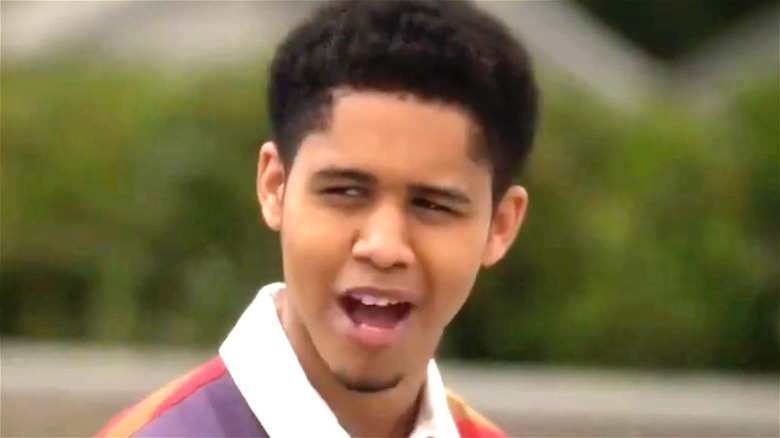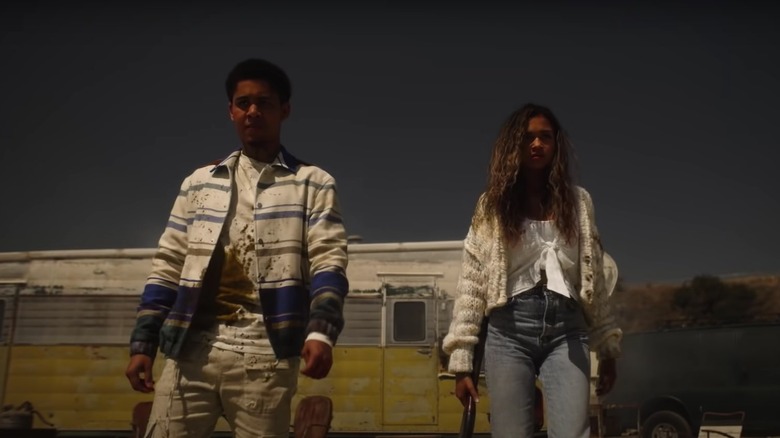The Scene From American Horror Stories: Drive In That Went Too Far
"American Horror Stories" continues its onslaught with its second story in the third episode, "Drive In" — a firmly self-aware horror tale about the concept of cursed films. Many films are dubbed cursed because of the fate of the stars. "Poltergeist" is a prime example of this. The tragic deaths of "Poltergeist" stars Dominique Dunne and Heather O'Rourke are sometimes attributed to the supposed curse on the film.
"Drive In" takes the opposite approach. "Rabbit Rabbit," the cursed film in "Drive In" is rumored to cause anyone who watches it to turn ultra violent — and it just so happens to be true. There's some historical precedent for this as a concept. There was, for example, a riot when Stravinsky's ballet "The Rite of Spring" first debuted in Paris on May 29, 1913 (via BBC). Whether or not it was really the music which caused the riot is a source for some debate, but there are enough reports to confirm that something did happen. The idea of a horror film that literally incites violence is interesting, albeit controversial. After all, the debate over violence in media rages on. Even now, we discuss whether or not violence in media directly correlates to violence in real life. There's a reason Tipper Gore appears in this episode — she notoriously helped form the Parents Music Resource Center and fought to have explicit content labels placed on music she deemed to filthy for children (via uDiscoverMusic).
But as tempting as it is to go political and say the lionizing of Tipper Gore in "Drive In" is the most "too far" moment in the episode, there's something else a lot more ridiculous that's worth calling out.
About that Rolls Royce
There are lots of things from "Drive In" we could judge as going too far. It's certainly a bummer watching a new horror story engage with old tropes by killing off the one non-binary character Dee (Ben J. Pierce) in the friend group first. But what we want to focus on is "Rabbit Rabbit" itself and its ultimate fate. Larry Bitterman (John Carroll Lynch) resurrects "Rabbit Rabbit" by recutting the film from a work print — a dodgy prospect from the word go. The likelihood of a workprint being viewable enough on a big screen to sell tickets is a little dodgy to begin with and that's before you calculate for the possibility that the film materials could've easily been damaged if vinegar syndrome had set in. It doesn't look like Bitterman takes great care of the movie print, so just from a film geek perspective, there are technical, nit-picky questions to be had.
However, nothing is more ridiculous than the specifics of how "Drive In" ends. We see the surviving heroes Chad (Rhenzy Feliz) and Kelley (Madison Bailey) making love when, as if by magic, Chad's Netflix automatically updates to show that "Rabbit Rabbit" is available to stream. That's not how Netflix really works. Moreover, we end by looking out the window and seeing chaos reign through the night with fires burning and people screaming everywhere. Didn't Netflix just add the movie? How many people have already chosen to watch a film that's largely unheard of by the average movie watcher? But more than anything there's the scene in which Larry screams that Chad and Kelley won't like the reason why Larry is able to own a Rolls Royce. Even a cheap Rolls Royce costs over $300,000 and we are meant to believe that Netflix would've paid in excess of that to Bitterman for a relatively unknown older film sourced from a workprint whose rights he might not even technically own?

